 Southern Railway ran The Southern Crescent which pulled 4 sleeper/lounge passenger cars, some times referred to as ‘The Crescent Sisters’ since all four cars were identical and built simultaneously. They were, The Crescent City (2350), The Crescent Moon (2351), The Crescent Harbor (2352), and The Crescent Shores (2353). Of the four cars, only 3 remain in existence today. Built in 1949 by the Pullman Company, these sleeper/lounge passenger cars were 85 foot long, and housed 1 master bed room, 2 drawing/bed rooms, a toilet, a small kitchen, and a lounge area that filled more then 1/3 of the car.
Southern Railway ran The Southern Crescent which pulled 4 sleeper/lounge passenger cars, some times referred to as ‘The Crescent Sisters’ since all four cars were identical and built simultaneously. They were, The Crescent City (2350), The Crescent Moon (2351), The Crescent Harbor (2352), and The Crescent Shores (2353). Of the four cars, only 3 remain in existence today. Built in 1949 by the Pullman Company, these sleeper/lounge passenger cars were 85 foot long, and housed 1 master bed room, 2 drawing/bed rooms, a toilet, a small kitchen, and a lounge area that filled more then 1/3 of the car.
 In Atlanta, chair-car attendant J.J. Mahone stands beside his car’s steps ready to help passengers board the Southern Crescent on it’s run between New Orleans and Washington, D.C.
In Atlanta, chair-car attendant J.J. Mahone stands beside his car’s steps ready to help passengers board the Southern Crescent on it’s run between New Orleans and Washington, D.C.
 Dinning cars of the Southern Crescent no longer have lavish interiors of polished mahogany; but sparkling crystal and snowy table linens help confirm continuing high standards of service.
Dinning cars of the Southern Crescent no longer have lavish interiors of polished mahogany; but sparkling crystal and snowy table linens help confirm continuing high standards of service.
 The Crescent City located at The Dalton Freight Depot in Dalton, Ga.
The Crescent City located at The Dalton Freight Depot in Dalton, Ga.
 The Crescent Moon located at the Tennessee Valley Railroad Museum in Chattanooga, TN.
The Crescent Moon located at the Tennessee Valley Railroad Museum in Chattanooga, TN.
 The Crescent Harbor is located at The Watauga Valley Chapter of the National Railway Historical Society in Johnson City, TN.
The Crescent Harbor is located at The Watauga Valley Chapter of the National Railway Historical Society in Johnson City, TN.
The Crescent Shores
The Lost Sister

About 5:38 a.m., on December 3, 1978, as the Southern Railway Company’s train no. 2, The Crescent, was passing through a 5 degree 15 minute curve at Elma, Nelson County, Virginia, eight cars and four locomotive units were derailed. Six persons were killed, 60 persons were injured, and property damage was estimated to be $557,500. The National Transportation Safety Board determines that the probable cause of this accident was the failure of the engineer to observe the track ahead because he was unnecessarily distracted by a transition problem, which led to his operation of the train into a 5 degree 15 minute curve at a high speed. The high speed produced excessive lateral forces which caused the wheels of either the fourth locomotive unit or the first car to climb out of the gauge, cross the head of the rail, and derail.

Newspaper Excerpts
Shipman, VA Train Wreck, Dec 1978
Posted November 11th, 2007 by Stu Beitler
Six Die In Train Mishap
SHIPMAN, Va. (AP) — “He was in tremendous pain, but never cried out,” a rescue coordinator says of a cook pinned 11 hours under a stove in the crumpled dining car of the Southern Crescent passenger train that derailed near here, killing six persons.
Bound from Atlanta to Washington, the Southern Railway train jumped its tracks at Elma, an abandoned Nelson County rail stop in mountainous central Virginia, about 5:30 a. m., Sunday.
Seven cars and three locomotives lay scattered like kindling in and around a shallow ravine beside the track. Only the lead locomotive, which broke away, and the last car remained untouched.
The 37-year-old cook, NED HAYNES of Atlanta, became the focus of attention from as many as 125 volunteer rescue workers after some 60 other passengers and crew were taken to hospitals in Lynchburg and Charlottesville.
“HAYNES is very brave,” said Capt. KIMBALL GLASS of the Lynchburg Rescue Squad.
“We fed him morphine with glucose to try to keep the pain down,” GLASS said. “He understood what we were doing. He asked us to pray for him and we all prayed for him. We talked to him and joked some with him.”
National Transportation Safety Board spokesman BOB BUCKHORN said an investigating team was sent to the scene to look for the probable cause of the derailment.
HAYNES and five other survivors were listed in critical condition at the University of Virginia hospital in Charlottesville. Twelve others were in satisfactory condition.
HAYNES suffered multiple trauma, burns and multiple fractures and was taken to the operating room and then admitted to the burn center, said WILLIAM L. LAMM, night hospital administrator.
Cleanup operations continued through the night. Southern Railway crews and a private contractor worked with cranes and bulldozers under portable lights to clear the single-track section of the railroad’s main line.
The railroad said the train carried 75 passengers and 15 crewmen.
The dead were identified as:
HOWARD LEWIS JACKSON, 59, of Alexandria, Va., a flagman.
LEWIS PRICE of Atlanta, a cook.
JACKSON HOMER HUME and EDITH CARROL HUME, an elderly couple from Madison Heights, Va.
EDWARD FRANKLIN SHAW, 14, of Wilmington, Del., said hospital spokesman BILL FISHBACK.
The sixth body, wedged under the wheel of a railroad car and the last to be removed from the scene about 10:40 p. m., was not identified late Sunday night pending notification of relatives.
Rescuers arrived on the scene about 6:10 a. m. and help poured in throughout the day down the one-lane, unused rail bed that served as a road to the isolated wreck scene.
Some passengers helped others out of cars, breaking laminated windows and prising open doors.
DR. J. DESMOND COUGHLIN of Ashville, [sic] N. C., who was riding with his wife to Washington to visit their son, stayed at the train to help. He suffered a facial laceration.
“He refused to be taken away from the train until everybody was taken care of,” said DR. KEN WALLENBORN of Charlottesville.
COUGHLIN is a Southern surgeon in Ashville.[sic]
He and his wife were riding with two railroad employees in the last car, a private coach often used by the railroad executives.
As medical technicians and a doctor huddled in the dining car kitchen with HAYNES, workers used bulldozers, cables and cutters to strip the stainless steel siding off the car so they could pull out the stove that pinned HAYNES.
“We used up 15 razor-type discs cutting the car,” GLASS said.
“As far as damage is concerned and the problems of getting a man out, this is the worst I’ve seen,” The veteran rescuer added.
Another cook lay dead in the compartment with HAYNES, GLASS said, and was removed several hours before HAYNES was brought out about 4:30 p. m.
“We had to get the dead man out,” he said. “Him seeing this man there with massive head injuries would have had some affect on him.”
About six survivors, including HAYNES, were trapped in various cars when rescuers arrived and all but HAYNES were gotten out quickly.
The News Frederick Maryland 1978-12-04
******************************************************************************************SHIPMAN, Va. (AP) – A Southern Railway passenger train jumped the tracks on a curve and piled into a ravine in mountainous south-central Virginia early Sunday. Authorities said six persons were killed and at least 60 were injured, several critically.
A severely injured cook was trapped for 11 hours in the debris of the smashed dining car, his legs pinned beneath a stove. Workers used bulldozers to peel back the side of the car and then life the heavy stove from the cook, NED HAYNES of Altanta.
DR. KENNETH WALLENBORN of Charlottesville, who climbed into the diner to attend HAYNES, said he had been pinned “from the pelvis down” and suffered third-degree burns on his chest and stomach and a broken ankle and leg.
“He is a man of tremendous intestinal fortitude … He has put up with a lot here,” WALLENBORN said.
At the scene, snow mixed with rain was falling in near-freezing temperatures. Blood was smeared on windows that had been broken when passengers escaped. Inside, seats were torn from their moorings and mattresses lay piled in a jumble in the aisles.
Four bodies were removed from the huge pileup of passenger cars and locomotives, and state police said two more bodies were known to be in the wreckage.
Four of the dead were identified as HOWARD LEWIS JACKSON, 50, of Alexandria, a flagman on the train; LEWIS PRICE of Atlanta, a cook; and JACKSON HOMER HUME and EDITH CARROL HUME of Madison Heights, Va. Names of the two other victims were being withheld until relatives could be notified.
Seven of the eight passenger cars and three of the four diesel locomotives of the Southern Crescent train, bound from Atlanta to Washington, piled up about 5:40 a. m. three miles north of Shipman, between Charlottesville and Lynchburg.
Railroad officials could not be reached for comment on how fast the train was going.
A Southern Railway spokesman said the train was carrying 65 passengers and a crew of about 12.
JOHNNY BRIDGES of Trenton, N. J., and TARIZ MUHAMMAD of Newark, N. J., were credited with leading many passengers to safety.
BRIDGES said it seemed to him the train “was sliding for about 10 minutes” after it jumped the tracks. “I could feel it just slide, just slide.”
MUHAMMAD said smoke was so thick in the dining car that “you couldn’t see people in the car from the outside .. but you could hear the screams.”
The cause of the derailment had not been determined.
CHARLES MORGRET, a spokesman for the Southern Railway, said, “There’s no way of telling at this early stage what caused the derailment.” A team from the National Transportation Safety Board was on its way to investigate.
A. H. SAWYER, associate administrator of the University of Virginia Hospital in Charlottesville, said 39 passengers were brought to the hospital.
He said five required surgery, but he did not know the nature of their injuries. All were reported in critical condition. The remaining 34 suffered cuts, scrapes and bruises and would be released from the hospital after receiving treatment, SAWYER said.
He said another 19 passengers were taken to the Martha Jefferson Hospital in Charlottesville, where they were treated for minor bumps and bruises.
Daily Herald Chicago Illinois 1978-12-04






 Two monorails collide head on. One driver, and two passengers were injured.
Two monorails collide head on. One driver, and two passengers were injured. 






 of Monorail Purple.
of Monorail Purple.





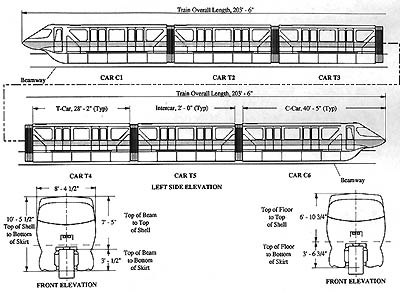

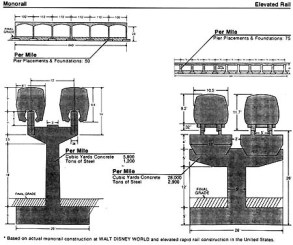
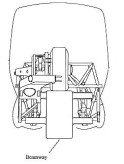
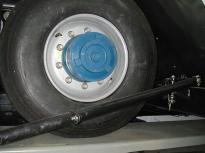
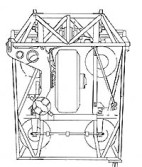
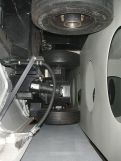
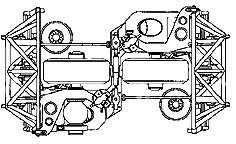
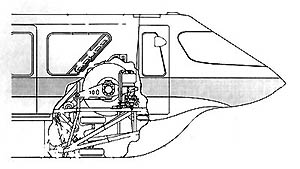
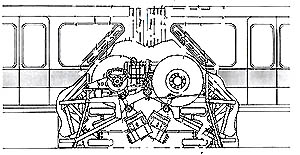 The propulsion system is called the “Propulsion and Dynamic Braking (P/DB) System.” There are two redundant P/DB systems per train, and either is capable of running the train. Each train consumes 138 KWH (kilowatt hours) per operating hour. This translates into a per-train mile of 10.78 KWH, or 0.13 KWH per passenger mile. Power is applied to the traction motors in steps to keep current consumption within the proper limits. Acceleration is 1 mph/s, deceleration is 0.44 mph/s.
The propulsion system is called the “Propulsion and Dynamic Braking (P/DB) System.” There are two redundant P/DB systems per train, and either is capable of running the train. Each train consumes 138 KWH (kilowatt hours) per operating hour. This translates into a per-train mile of 10.78 KWH, or 0.13 KWH per passenger mile. Power is applied to the traction motors in steps to keep current consumption within the proper limits. Acceleration is 1 mph/s, deceleration is 0.44 mph/s. Each car has 4 doors, two on each side. The trains are fully air conditioned. Each Mark VI car can carry 20 passengers seated and 40 passengers standing. Thus, each train can carry 360 people.
Each car has 4 doors, two on each side. The trains are fully air conditioned. Each Mark VI car can carry 20 passengers seated and 40 passengers standing. Thus, each train can carry 360 people.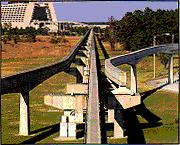
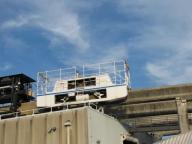
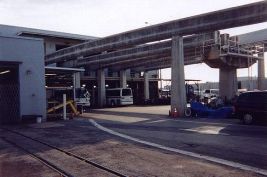


 In Atlanta, chair-car attendant J.J. Mahone stands beside his car’s steps ready to help passengers board the Southern Crescent on it’s run between New Orleans and Washington, D.C.
In Atlanta, chair-car attendant J.J. Mahone stands beside his car’s steps ready to help passengers board the Southern Crescent on it’s run between New Orleans and Washington, D.C. Dinning cars of the Southern Crescent no longer have lavish interiors of polished mahogany; but sparkling crystal and snowy table linens help confirm continuing high standards of service.
Dinning cars of the Southern Crescent no longer have lavish interiors of polished mahogany; but sparkling crystal and snowy table linens help confirm continuing high standards of service. The Crescent City located at The Dalton Freight Depot in Dalton, Ga.
The Crescent City located at The Dalton Freight Depot in Dalton, Ga. The Crescent Moon located at the Tennessee Valley Railroad Museum in Chattanooga, TN.
The Crescent Moon located at the Tennessee Valley Railroad Museum in Chattanooga, TN. The Crescent Harbor is located at The Watauga Valley Chapter of the National Railway Historical Society in Johnson City, TN.
The Crescent Harbor is located at The Watauga Valley Chapter of the National Railway Historical Society in Johnson City, TN.



 The original Crescent Limited train name dates to 1925 when Southern began a deluxe all-Pullman sleeper train (no coaches), equipped with observation and club cars that operated from New York to New Orleans through agreements with several other railroads. In 1926 it was assigned brand new heavy 4-6-2 passenger locomotives, painted green and gold with the train’s name on the tender. One of these elegant Ps-4 class Pacific’s is on display in Railroad Hall at the Smithsonian Institute’s American History Museum in Washington, D.C. This locomotive also hauled the funeral train of President Franklin D. Roosevelt in 1945.
The original Crescent Limited train name dates to 1925 when Southern began a deluxe all-Pullman sleeper train (no coaches), equipped with observation and club cars that operated from New York to New Orleans through agreements with several other railroads. In 1926 it was assigned brand new heavy 4-6-2 passenger locomotives, painted green and gold with the train’s name on the tender. One of these elegant Ps-4 class Pacific’s is on display in Railroad Hall at the Smithsonian Institute’s American History Museum in Washington, D.C. This locomotive also hauled the funeral train of President Franklin D. Roosevelt in 1945.
 The original Crescent Limited name disappeared for four years during the Depression as the railroad downplayed the “luxury” aspect and coaches were added to the consist. The train was renamed the Crescent in 1938 as the older coaches were replaced by new air conditioned equipment . Diesels replaced the famed locomotives in 1941 just in time for heavy use during World War II.
The original Crescent Limited name disappeared for four years during the Depression as the railroad downplayed the “luxury” aspect and coaches were added to the consist. The train was renamed the Crescent in 1938 as the older coaches were replaced by new air conditioned equipment . Diesels replaced the famed locomotives in 1941 just in time for heavy use during World War II.

 In 1971, the year Amtrak was created to save the national passenger system, the Southern was operating only four trains, two between Washington and Atlanta (the Piedmont, trains 5 and 6 – run as a mixed train with trailer flat cars, as well as being used for shuttling motive power on the system), and New Orleans (the Southern Crescent, trains 1 and 2), and two unnamed branch line runs, Nos. 3 and 4 in North Carolina and Nos. 7 and 8 in Virginia. Southern was losing $2.3 million annually but declined to join the infant Amtrak and opted to run their remaining trains for five years before seeking any change, subsidizing the trains with freight profits. The railroad also rerouted the Southern Crescent south of Atlanta via Birmingham over an all-Southern route, rather than Montgomery where the connecting railroads had decided to get out of the passenger business and join Amtrak.
In 1971, the year Amtrak was created to save the national passenger system, the Southern was operating only four trains, two between Washington and Atlanta (the Piedmont, trains 5 and 6 – run as a mixed train with trailer flat cars, as well as being used for shuttling motive power on the system), and New Orleans (the Southern Crescent, trains 1 and 2), and two unnamed branch line runs, Nos. 3 and 4 in North Carolina and Nos. 7 and 8 in Virginia. Southern was losing $2.3 million annually but declined to join the infant Amtrak and opted to run their remaining trains for five years before seeking any change, subsidizing the trains with freight profits. The railroad also rerouted the Southern Crescent south of Atlanta via Birmingham over an all-Southern route, rather than Montgomery where the connecting railroads had decided to get out of the passenger business and join Amtrak. But passenger losses continued to mount, and the fleet of cars and engines available was aging, the most recent dating to the early 1960s. By 1977, when the three lesser trains had already been discontinued (in 1975), Southern Crescent operating losses had grown to $6.7 million annually. Unwilling to invest in new rolling stock or to compromise the quality of the ride, Southern petitioned to end operation on April 5, 1978. However, outcry from affected communities and supporters of rail transit forced the railroad to go through ICC-mandated local train-off hearings before halting service.
But passenger losses continued to mount, and the fleet of cars and engines available was aging, the most recent dating to the early 1960s. By 1977, when the three lesser trains had already been discontinued (in 1975), Southern Crescent operating losses had grown to $6.7 million annually. Unwilling to invest in new rolling stock or to compromise the quality of the ride, Southern petitioned to end operation on April 5, 1978. However, outcry from affected communities and supporters of rail transit forced the railroad to go through ICC-mandated local train-off hearings before halting service. After a
After a 

 Southern Railway came into existence in 1894 through the combination of the Memphis and Charleston Railroad, the Richmond and Danville system and the East Tennessee, Virginia and Georgia Railroad. The company owned two-thirds of the 4,400 miles of line it operated, and the rest was held through leases, operating agreements and stock ownership. Southern also controlled the Alabama Great Southern and the Georgia Southern and Florida, which operated separately, and it had an interest in the Central of Georgia.
Southern Railway came into existence in 1894 through the combination of the Memphis and Charleston Railroad, the Richmond and Danville system and the East Tennessee, Virginia and Georgia Railroad. The company owned two-thirds of the 4,400 miles of line it operated, and the rest was held through leases, operating agreements and stock ownership. Southern also controlled the Alabama Great Southern and the Georgia Southern and Florida, which operated separately, and it had an interest in the Central of Georgia. Southern’s first president, Samuel Spencer, drew more lines into Southern’s core system. During his 12-year term, the railway built new shops at Knoxville, Tennessee, and Atlanta, Georgia and purchased more equipment. He moved the company’s service away from an agricultural dependence on tobacco and cotton and centered its efforts on diversifying traffic and industrial development. Spencer was killed in a train wreck in 1906.
Southern’s first president, Samuel Spencer, drew more lines into Southern’s core system. During his 12-year term, the railway built new shops at Knoxville, Tennessee, and Atlanta, Georgia and purchased more equipment. He moved the company’s service away from an agricultural dependence on tobacco and cotton and centered its efforts on diversifying traffic and industrial development. Spencer was killed in a train wreck in 1906. By the time the line from Meridian, Mississippi, to New Orleans, Louisiana was acquired in 1916 under Southern’s president Fairfax Harrison, the railroad had attained the 8,000-mile, 13-state system that marked its territorial limits for almost half a century.
By the time the line from Meridian, Mississippi, to New Orleans, Louisiana was acquired in 1916 under Southern’s president Fairfax Harrison, the railroad had attained the 8,000-mile, 13-state system that marked its territorial limits for almost half a century. The Southern Railway was notably the first Class I railroad in the United States to completely convert to diesel motive power. On June 17, 1953, the railroad’s last steam-powered freight train arrived in Chattanooga, Tennessee behind 2-8-2 locomotive No. 6330.
The Southern Railway was notably the first Class I railroad in the United States to completely convert to diesel motive power. On June 17, 1953, the railroad’s last steam-powered freight train arrived in Chattanooga, Tennessee behind 2-8-2 locomotive No. 6330. In response to the creation of CSX in 1980, the Southern Railway merged with Norfolk and Western Railway to form the Norfolk Southern Railway in 1982, further consolidating railroads in the eastern half of the United States.
In response to the creation of CSX in 1980, the Southern Railway merged with Norfolk and Western Railway to form the Norfolk Southern Railway in 1982, further consolidating railroads in the eastern half of the United States.

 The original operating lines were the Express loop, servicing the Transportation & Ticket Center to the entrance to the Magic Kingdom, and the Resort loop servicing the T&TC and the entrance to MK along with the Polynesian Resort and the Contemporary Resort, The Grand Floridian Resort was added in 1988.
The original operating lines were the Express loop, servicing the Transportation & Ticket Center to the entrance to the Magic Kingdom, and the Resort loop servicing the T&TC and the entrance to MK along with the Polynesian Resort and the Contemporary Resort, The Grand Floridian Resort was added in 1988. 















 the right most door of each car can be opened by a cast member by releasing the air pressure with a safety release handle on the outside of the train.
the right most door of each car can be opened by a cast member by releasing the air pressure with a safety release handle on the outside of the train.
 Passengers can then move along the roof to an adjacent car and await evacuation. In the event of a full train evacuation, passengers move along the roof of the train toward one of the cab units, where the pilot attaches a knotted rope to the top and bottom of the windshield, allowing passengers to climb down over the nose of the train to the beam where they can walk along, away from the train.
Passengers can then move along the roof to an adjacent car and await evacuation. In the event of a full train evacuation, passengers move along the roof of the train toward one of the cab units, where the pilot attaches a knotted rope to the top and bottom of the windshield, allowing passengers to climb down over the nose of the train to the beam where they can walk along, away from the train.